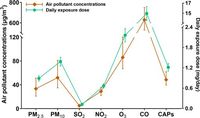A retrospective analysis has revealed significant links between air pollution and increased serum uric acid levels, shedding light on potential mechanisms that could contribute to kidney dysfunction in exposed individuals.
Conducted on 233 participants, the study found that higher daily exposure to combined air pollutants (CAPs) correlates with elevated levels of uric acid, a compound associated with various health risks including gout and kidney disease.
The mean daily exposure dose (DED) for CAPs was set at 1.22 mg/day, distinguishing participants into lower-exposure (LEG) and higher-exposure (HEG) groups. Results indicated that those in the HEG exhibited higher counts of various peripheral blood cells—such as white blood cells (WBCs), eosinophils, basophils, and red blood cells—compared to their lower-exposure counterparts. Conversely, platelet counts were lower in the HEG. Simultaneously, serum uric acid levels were significantly elevated in the HEG, averaging 424.76 µmol/L compared to 334.57 µmol/L in the LEG, which poses important implications for public health.
Previous research has established a connection between air pollution and kidney problems, with this study further supporting that notion by identifying a link to inflammation possibly caused by air pollution-induced changes in peripheral blood cells. Multivariate models suggested that as exposure to air pollutants increased, peripheral blood cells and serum uric acid levels also rose, indicating a concerning trend especially for populations residing in urban settings with poor air quality.
It is known that uric acid is a byproduct of purine metabolism and can lead to numerous health complications when present in excess, including gout, chronic kidney disease, and cardiovascular issues. The findings from this analysis present new insights into how environmental factors such as air pollution can exacerbate these health risks.
The study employed electronic health records and air quality data collected from Mianyang City over the span from September 2018 to September 2019, using rigorous statistical methods to ensure accuracy in linking air pollution exposure with health outcomes. Statistical significance was determined with p-values less than 0.05, reinforcing the reliability of the data.
As the authors note, “peripheral monocyte counts play a mediating role in the dose effect relationships between air pollutant exposures and serum UA levels.” This reinforces the notion that air pollution doesn't merely have immediate effects but can induce systemic inflammation that compounds the risk of chronic health conditions.
The implications of these findings extend beyond individual health; they emphasize the critical need for urban air quality improvement and highlight the long-term risks posed by environmental pollutants. The researchers recommend that effective ecological and environmental protection policies should be implemented to safeguard public health and to mitigate the adverse effects of air pollution.
Improving air quality has proven beneficial in many areas, yet cities like Mianyang continue to struggle with air pollution levels that far exceed World Health Organization guidelines, making it imperative for ongoing public health initiatives aimed at reducing airborne contaminants.
This comprehensive analysis thus lays the groundwork for future research that could further explore these relationships and ultimately aid in crafting effective health policy recommendations for vulnerable populations.




